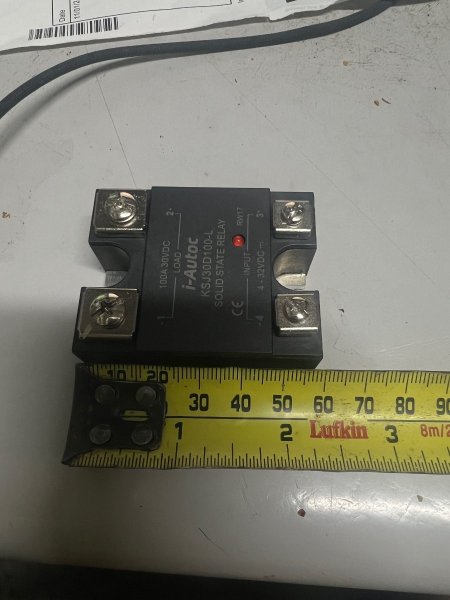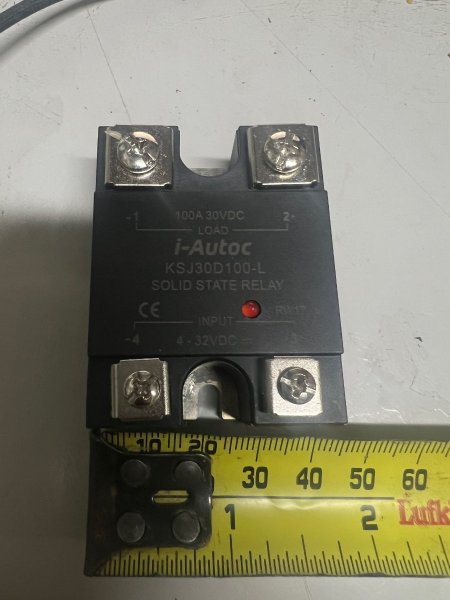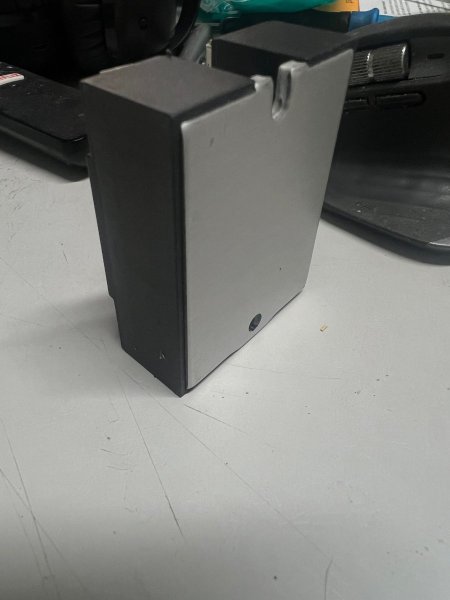-
Posts
6,596 -
Joined
-
Last visited
-
Days Won
95
Content Type
Profiles
Forums
Gallery
Downloads
Blogs
Events
Store
Aircraft
Resources
Tutorials
Articles
Classifieds
Movies
Books
Community Map
Quizzes
Posts posted by Kyle Communications
-
-
I have a dynavibe..they work well. Bought it secondhand for about 1200 quite a few years ago now.
-
No they are typically FETS..they are a voltage device rather than a current based device. Essentially they work like a switch when you place a voltage onto the gate and the drain and source then conduct. They are still semiconductors but they dont have any gain like a transistor does. I am trying to keep this as simple as I can because this subject is huge now. FETS are almost taking over the world 🙂
They are silicon switch for a better word. FETS are really common now and most of all your solar inverters and your power inverters etc..anything that switches on and off ans fast they are generally FETS now. They can take a crap load of current through them because their "on resistance" is very small. A lot of FETS have resistance across the junction like 0.28 of an ohm when turned on and even less. There is a mininum voltage that they turn on with but there is still a current limit as the junction resistance is not the lowest until the voltage gets to a higher level.
There are so many types of FETS now its crazy...infact RF Output devices are commonly FETS now and are used regularly ...and I am talking lots of power. LDMOS type ones are regularly 1.5kw RF out
Infact the main RF output device in a Xcom airband radio is a FET
-
 1
1
-
-
Skippy you wouldnt want to be running any starter motor current through that thing
-
 2
2
-
-
The wattage loss is very low even at 10 amps (6 watts max) which would be the most current drawn from a dual efis system and ancillaries. That is only while it is turned on. With semiconductors the limiting factor is the device's junction temperature. The reason I dont like relays is it is drawing all your avionics load current through a spade terminal. I much prefer the screw/boltability of the SSR to take all the load. As a case in point just look how many Rotax regulators end up with burnt out spade terminals on the regulators...I would know of 20 or 30 at least...I dont like them odds...its just not a good thing..Thats why AC43 pretty much specifies ring terminal connections when possible
-
 1
1
-
-
no he had a carb engine spring fail and the engine was running very rough so he put down on the island...emerg services came but they got it sorted and continued onto tasmania
-
 2
2
-
 2
2
-
-
Where is Hogan Island?..There was a incident I know of in Bass Strait. but it wasnt a savannah
-
-
I did mine a few weeks ago now...did the online stuff and filled out the stuff flashed my CC and literally 45 sec later my medical class 5 appeared in my email.
Mark
-
 1
1
-
 1
1
-
 1
1
-
-
Nev I know the differences of each to me its the same result. Just different purposes. After 43 years as a electrical fitter mechanic special class ( industrial electronics) and also a radio tech....I think I know what versions are used for what tasks. Working on 11kv and 33kv and 110kv circuit breakers...using solenoid style actuation and distribution authority electrical substation protection and control systems using hundreds of relays also fault finding and contruction of those substation controls..The last 10 years also doing design and development of mains connected power electronics for mass production sets of products to me they are essentially the same just a different scale and type for the purpose.
As I said its semantics to me. You just use the APPROPRIATE DEVICE for the job. As I stated I much prefer to use a manual isolation switch within my reach in the cabin rather than a solenoid to isolate a battery that I have my arse sitting in.
-
 1
1
-
-
WEEEEELL it is semantics really. A relay is still a electromagnet coil and so is a solenoid. The solenoid is a much larger device designed to switch a much larger load and it does have a core that moves internally. The relay is pretty much exactly the same but in a smaller footprint and designed to handle a lot less current but it does the same thing. The relay though does tend to have a "switch" as contacts being NO and NC but there are exceptions where there is only one set of contacts which are NO similar to a solenoid. so it could be semantics or it could be definition..either way they both do the same thing.
Yes you could have a solenoid working off a master switch in the aircraft that does isolate the battery. I have seen plenty of "solenoids" fail in my work life and to be honest I dont think I have ever seen a properly rated isolation switch fail. It is a peronal choice I suppose which way you want to go. To me I like the big manual switch right where it can be accessed from the pilot position.
-
 1
1
-
 1
1
-
-
When referring to a Master in a aircraft it usually means the main electric buss for the internal DC for the aircraft. Not the whole system for the aircraft including battery. I believe what you wanted was a isolation switch. I will always have a isolation switch for the very reasons you give above, That really is a given. The master is not that. It is just wordings I suppose and it all just means take accepted practices for making safe the whole electrical system in the aircraft. How far you want to go with that is up to the builder...and the rules of course. There is no requirement for a isolation switch in any aircraft...but it just makes good sense because if a fault like that occurrs you cant just get out of the vehicle at 7000 ft...unless you got a parachute on 🙂
-
 2
2
-
-
The SSR I posted is NOT for the starter motor to use it is only for the MASTER..which is for the internal DC for aircraft. The starter has a usual generic solenoid/relay to take the many hundreds of amps at start. I would never use it to switch starter motor current. Semantics of wether it is a solenoid or a relay is nit picking words...we all know what it is and what it does
-
 2
2
-
-
1 hour ago, danny_galaga said:
I think 100 amps would be a bit marginal,even for the motorcycle starter the 912 is using. My isolator is rated at, I think 1000amp for 20 seconds and 100 amp continuous. That's overkill, but it's actually the smallest I could find 😄
I always use continuous rated switches....none of this 20 sec stuff as they never cut the mustard. 100 to 200 amps continuous..same as this solid state relay its apparently 100 amps continuous Max Surge 260 amps for a short time..heaps of overkill for a master but solid state DC switches are a bit hard to get
This mob below also sell Tefzel wire...it all mainly supplied for race cars on this site. But its local here in brisbane
 12-24V 100A Solid State Relay
WWW.NRTAUTOMOTIVE.COM.AU
12-24V 100A Solid State Relay
WWW.NRTAUTOMOTIVE.COM.AU
Solid state relays (SSR) have no moving parts, eliminating failures normally associated with conventional mechanical switching relays. Rated up to 100A, this SSR provides faster switching time, improved...-
 2
2
-
-
I have been reading through this thread and to be honest there are a lot of misconceptions here. RFGuy is correct on everything.
Always have a isolator switch direct from the battery terminal somewhere as first port of call for isolation. Put that in the negative lead to isolate the return path from anywhere on the frame of the aircraft. This switch needs to be able to pass the 100 to 200 amps that the starter motor requires....
A regulator is a regulator but yes there are older style linear regs and later switching regs but all really need a large capacitor to ensure the electrical buss has filtered flat DC to all the electronics or electrical equipment that requires DC. The capacitor is just a big filter thats all.
Diodes are usually 600V PIV in most regulators so highly unlikely of any breakdown if the alternator goes open.
Most regulators and especially the genuine Rotax one usually fail internally by heated spade terminals or pcb failures due to being under designed to take the amount of current through those terminals for a long time. This higher current causes heat because ALL connections have some resistance which will create heat and over time this resistance gets higher and then the heat becomes more and so on until there is a failure.
Its a good idea to have a master relay..this is usually a solenoid style but those contacts can still weld together..there are some new solid state DC relay ones good for 100 amps that look really good and I am actually going to use these in my next 2 aircraft instead of the older solenoid style type.
DC buss needs to be clean..the only way to clean the lumps off the "rectified AC" this stops the noise and buzzing etc in your radio and also much better for any EFIS style equipment
-
 1
1
-
 3
3
-
-
Just beg borrow or steal flatbed trailer. Its easy enough. I bought Mabel from western mid NSW and bought her all the way to north of Brisbane on a trailer. Wasnt a drama at all. Just took her this week down to the hangar for final assembly when I can get a chance to work on her.She has been a long project to totally rebuild from scratch
-
 2
2
-
-
Well I jumped through the hoops and have now got the class. 5 medical....was all pretty easy with the online course and quizz and it literally came in 30 sec after paying. I had to email my medical certificate to Avmed so will see what comes of that.
Mark
-
 1
1
-
 2
2
-
-
hahahha I may as well have I think. But all that tech hasnt caught up with me yet
I think its called paying for the sins of my youth 🙂
-
yes there is although its on a Kitfox not a speed machine. This is the only one I know of
They have a hydraulic module they think its better than electric but they do have a config 3 version that is electric
They have a manual version coming but it is for the 912 IS and the 915 IS...i think because the hole in the gearbox maybe different
https://aircraft.e-props.fr/GL_CS/#tit04
-
They told me exactly what I just said above. IF you have all the required endorsements and qualifications and the aircraft is fitted out correctly with all the right gear you apparently are able to. It was a surprise to me as I was always told...by others I must adnit that you needed a "certified" aircraft ..like a factory built etc used for training
-
yes apparently so...I was told this just recently when I was discussing it with shall we say...someone who knows..and they make the rules
-
 1
1
-
-
Make sure he sets WOT at 5500. A manual IFA would be great i think but Eprop only do the Glorieus which is hydraulic with a controller. Realistically for our sort of high wing aircraft its a expensive option for not a huge difference. If you had a fast machine like a Blackshape well then yes you will get a super top end speed but our aircraft have too much drag
-
 1
1
-
 1
1
-
-
You can fly RAA into CTA if you aircraft is equipped with the right gear and you have the appropriate endorsements...apparently you always have been able to..the issue was of course it can be a RAA aircraft but you needed a RPL or a PPL to do it with the assosiated equipment on board
-
 1
1
-
-
Mike I would have thought you would have seen the guys that put it at 5800..that is for IFA props NOT ground adjustable. Eprop also have specifically designed their props to work on Rotax engines with gearboxes and also their slightly different ratios. I cant seem to convince the old guys that 5800 is NOT where you should place any ground adjustable prop on a Rotax with a gearbox. Just think about it. Yes it maybe a little better at takeoff with the fine pitch but as soon as you want cruise if you set the pitch to 5800 at WOT then when you bring it back to cruise you will NOT have the same thrust at `5000 rpm as when you set your WOT to 5500 rpm...that is just mother nature.
That video of Jonas is specific to stol takeoff and short straight around circuit...NOTHING else..its a specific thing. I think he does mention something about it.
I have had a few customers who did not listen to me and set the props at 5800 because the guru at the airfield said this is how you do it. You listen to the designers of the prop.
Mark
-
 1
1
-
 1
1
-
 2
2
-
-
My whole reason for going Group G was the medical. That now according to the CASA blurb can go out the window. I do not need to do my Austroads medical each year with my GP AND then go to a DAME to get a basic class 2 licence. This takes the DAME out of the situation and of course the cost. I have enough costs every year just to comply with my heavy vehicle licence. I maintain my heavy vehicle licence just for this reason so if I can drive a 64 tonne semi on any road allowed in Australia with my "special conditions" then I can certainly fly a aircraft with 2 people and under 2000kg. Every year I have a double appointment with my Dr to get the Austroads sign off then I have a cardiologist appointment every year with ECG every time. Every second visit there is a cardiac echo and every 4th year there is a stress test..and blood tests every 3 months for HB1AC .all this costs big bucks. With Class 5 well I can drop at least the double Austroads appointment and just do a std drivers licence medical each year with my normal doctor. In my case I KNOW what condition my heart is in and my body and endorine system is in...how many of you out there KNOW this about their own bodies.?..I may have had "some work done" but I KNOW exactly where I stand with my health...do you????
I can now re engine my S-21 with a engne bigger if I want to now and fly at the MTOW of 820kg instead of the Rotax MTOW of 727 kg.
I have been thinging about this and think I may actually just do a turbo rotax which will give me between 135 and 145 hp..that will be heaps. The guy in melbourne does it to a std Rotax...not a big bore version like mine but its cheaper for me to do another complete overhaul of a out of time 912ULS and spend the 11K to do the turbo. I like this conversion because its a basic turbo conversion it does not have all the fancy electronic BS or the 915 and other after market engines. A local guy at my airfield has just put one in his Searey. We stuck a 4 blade Eprop on it and it has gone from 75 to 80 kts cruise to 96kts !!!!! at 5240 rpm. He still needs to further adjust the prop pitch which should make even more difference. The Searey is a bigger drag bucket than any savannah. If I did do this conversion I could still stay in Group G but would still be weight limited. The S-21 is HP limited for weight but that did not account for the higher HP Rotax engines.
Mark
-
 2
2
-
 1
1
-
 2
2
-







.jpg.2502bd88c5e0b07666f4c0152ffbbef6.jpg.35dbadc12e4e3e8c2c6330d692a6a73a.jpg)
.jpg.803a62df18c15c5b861d1b01cd852e7d.thumb.jpg.9d1cff7ec6c210bd38713a407fb3874a.jpg)






Dynamic Prop Balance
in Engines and Props
Posted
I bought it to keep my bolly at the time in good nick for the engine. It has balanced quite a lot of engines now since I have had it. I have a L2 that borrows it a bit when servicing some aircraft even GA ones it has done. It was probably some overkill really for just my aircraft but at the time I was a bit flush and could spare the cost without a second thought.
I of course do Eprop and they are all prebalanced but I dont think I would ever sell it. Its what I class as "test equipment"...There are some things I will never sell. That is all my very expensive RF test equipment and other electronic test gear also my lathe and my CNC Mill..There are some things once you manage to either fund or beg borrow or steal that you end up never selling. They only go when they are broken beyond repair or its by the execetor of your will....I think its a thing that most radio techs do. I bet if you ask RFGuy he doesnt get rid of his prized test equipment even if you only use it once a year 🙂